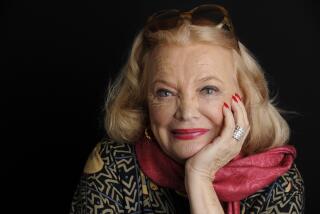From the Archives: Anne Bancroft, Versatile, but Forever ‘Mrs. Robinson’
Anne Bancroft, the versatile, husky-voiced actress who won an Academy Award for portraying Helen Keller’s teacher in “The Miracle Worker” but will forever be remembered as the coldly seductive Mrs. Robinson in “The Graduate,” has died. She was 73.
Bancroft died Monday night of uterine cancer at Mt. Sinai Hospital in New York City, John Barlow, spokesman for Bancroft’s husband, entertainer Mel Brooks, announced Tuesday.
An actress of uncommon versatility, Bancroft collected one Oscar, two Tonys, two Golden Globes, an Emmy and in 1996 a lifetime achievement comedy award in a career spanning more than half a century.
Bancroft earned a Tony and an Academy Award for best actress in “The Miracle Worker” as Annie Sullivan, the willful and determined half-blind teacher of Patty Duke’s blind and deaf Keller. The Broadway and motion picture versions of William Gibson’s play established Bancroft as a multifaceted actress with deep talent.
Duke, who was 12 when she began working with Bancroft, was in tears Tuesday as she told The Times: “I don’t know if we’ll ever see the particular likes of her again.... I am blessed to have ever been in her presence. I am devastated.... But she leaves us with that great, throaty rasp and that wicked sense of humor.”
Arthur Penn, director of the stage and screen versions of “The Miracle Worker,” called Bancroft “a magnificent actress, a woman of rich, rich emotion and great humor.”
Dustin Hoffman, who played the callow post-collegiate youth to Bancroft’s world-weary Mrs. Robinson in “The Graduate,” said Tuesday that he could not think of her in the past tense.
“She was one of the most alive people I ever met,” he told The Times. “Such exuberance, and she had this laugh in her that filled her from head to toe. I can see her, see her laughing right now.”
Mike Nichols, who directed “The Graduate,” called Bancroft a masterful performer and said in a statement Tuesday, “Her combination of brains, humor, frankness and sense were unlike any other artist. Her beauty was constantly shifting with her roles, and because she was a consummate actress, she changed radically for every part.”
Bancroft was nominated for Academy Awards for four more films -- “The Pumpkin Eater” in 1964; “The Turning Point” in 1977; “Agnes of God” in 1985; and her most popular, “The Graduate” in 1967. She collected Golden Globes for “The Pumpkin Eater” and “The Graduate.” There were also many nominations for other awards.
For several generations of film fans and moviegoers, mere mention of “The Graduate” immediately conjures up memories of Simon & Garfunkel’s tuneful phrases: “And here’s to you, Mrs. Robinson, Jesus loves you more than you will know....”
The movie title also evokes images of Hoffman, as the son of her husband’s law partner, saying with slow realization, “Mrs. Robinson -- you’re trying to seduce me ... aren’t you?”
In a 1969 essay, film critic Pauline Kael described “The Graduate” as a movie that, while “aesthetically trivial,” penetrated the national culture because it so deftly reflected it. With its focus on middle-class alienation, it appealed to moviegoers because it gave them the sense that they knew what was going on. “They don’t see the movie as a movie,” she wrote, “but as part of the soap opera of their lives.”
Although she was playing a woman old enough to be his mother, Bancroft was 35 and Hoffman was 30 when they filmed the movie.
But Hoffman said Tuesday that he looked up to her nonetheless because of her far greater acting experience.
“I was so grateful to work with someone so seasoned,” he told The Times. “She had done ‘The Miracle Worker.’ She knew the boards. She was naturally theatrical. She just went right through you, pierced you.
“She had that elegance, but she was also street,” Hoffman added. “A stoop kid, a neighbor who would lean out the window and yell down to you.”
Recognized forever after as Mrs. Robinson -- the fantasy older woman willing to teach nervous young men about sex -- Bancroft resented the film’s domination over other career accomplishments that she considered more important.
“I’m still trying to get away from it,” she told The Times in 1997.
The entertainment community sympathized with the actress’ pique, but nevertheless loved the character as much as the public.
“Sometimes, there’s something about a role that is so unforgettable, that it’s just very hard to get away from it,” Charles Champlin, former arts editor and film critic of The Times, said Tuesday.
“It’s hard to think of that actor or actress in any other performance. In that respect, she will be Mrs. Robinson....”
But Bancroft’s feeling about the indelible identity never stopped her from sharing her razor-sharp insight into Mrs. Robinson any more than it kept her from taking on widely diverse and difficult roles in other projects.
“Mrs. Robinson was using sex as a way to diffuse this rage inside of herself,” she told The Times in 2000, more than 30 years after the film’s debut.
“The rage was about her dreams not coming true, her youth being gone. She’s out to assuage all these terrible feelings she has. And the only thing she has been able to find, since art was taken away from her -- you see, she studied art in college -- is sex. It’s easy. So having this naive little kid, Benjamin, that Dustin Hoffman played, teaching him everything she liked and wanted -- what could be better? She uses sex to forget. She just punished everybody and everything, and used the sex.”
Glamorous and frosty in “The Graduate,” Bancroft easily morphed into a mother superior in “Agnes of God,” an aging ballerina in “The Turning Point,” a wily U.S. senator in “G.I. Jane,” and even Israeli Prime Minister Golda Meier for Broadway’s “Golda.”
“She can do anything. She could play Queen Victoria in a minute. She’s a magnificent actress in every possible respect,” director Penn told The Times in 1997.
He added Tuesday that if Bancroft had concentrated solely on the stage, “I have no doubt she would have become the true first lady of the American theater.”
In Penn’s view, her great strength was “her emotional availability. She could draw on her emotions. They were available to her. That is very hard for people to do night after night and play after play. To be able to do what she was doing was extraordinary.”
Champlin said Tuesday that Bancroft “was one of the best actresses of her generation, of our time. Look at ‘The Miracle Worker.’ She became that character. It was a miraculous portrayal....”
“She acted with a terrific intensity,” Champlin added. “She could lose herself in a part, and she just became whoever she was playing. Good actresses can always do that, of course, but some can do it more than others. That was Anne.”
It didn’t start out that way. She was born in the Bronx, N.Y., as Anna Maria Louisa Italiano on Sept. 17, 1931.
After studying at New York’s American Academy of Dramatic Arts in 1948, then credited as Anne Marno, she began acting in live television in 1950 on such programs as the drama anthology “Studio One.”
Signed to a contract by 20th Century Fox, she moved to Hollywood in 1952 and chose her stage name -- Bancroft, because it sounded dignified -- from a list handed to her by studio head Darryl F. Zanuck.
For the next five years she ground out such B-pictures as “Demetrius and the Gladiators,” “Gorilla at Large” and “The Girl in Black Stockings.”
The studio promoted her looks, not her acting, and she didn’t argue.
“My goal was simply to be a movie star. I had no idea what to be an actress meant,” she once told The Times. “It was just to be famous and popular and powerful and rich.”
But she found no satisfaction in what she was doing until she returned to New York for the Broadway role as Gittel Mosca, a Jewish Bohemian dancer from the Bronx, opposite Henry Fonda in “Two for the Seesaw” in 1958. The performance earned Bancroft her first Tony.
“I began to know what I wanted,” she said. “I really wanted to learn how to act.”
At night, she threw herself into developing a strong Irish accent and rehearsing with Duke for “The Miracle Worker” and learned as much as she could from Penn, who had also directed “Two for the Seesaw.”
Duke said Tuesday that it was Bancroft who helped her feel at ease in the play although she was still a child.
“The magic didn’t start to happen until I stopped being in awe of her. She is the one who whittled that down for me. She was the one who made sure she was down to my level. I don’t know if it was because we were two New York street kids, but from then on we just clicked.”
When she wasn’t working on the play, Bancroft studied at the Actors Studio.
She was dancing on the workshop’s stage when she met the comedian, writer and director Mel Brooks.
“I said to myself, ‘That guy looks like my father, and acts like my mother. He’s for me!’ ” she told The Times in 2000. He followed her around and kept her laughing until she married him in 1964.
Bancroft, who had been married to Martin May during her Fox contract player days in Los Angeles, accommodated her schedule to her new marriage to Brooks, especially after the birth of their son.
Hoffman recalled the couple’s close relationship while he and Bancroft were filming “The Graduate.”
“Mel called her every day. She kept telling me ‘Mel called again today. He wants to know if I’ve kissed you yet. He’s so jealous.’ And on Fridays, she’d be saying, ‘Could you hurry up, could you get it right? I need to get on a plane. I want to see Mel.’ They were like kids. It is one of the greatest marriages -- nothing showy, nothing fake but you knew they were real lovebirds.”
Some friends cited Bancroft’s devotion to Brooks as an illustration of her own natural gift for laughing and making others laugh. “You don’t marry Mel Brooks,” Penn said, “if you don’t have a sense of humor.”
But even when Bancroft put family first, the credits kept coming. She segued easily from leading lady to character actress.
Films included John Ford’s final motion picture, “7 Women” in 1966, “Silent Movie” with Brooks in 1976 and “To Be or Not to Be” again with Brooks in 1983, along with “Garbo Talks,’ “ ‘Night, Mother,” “84 Charing Cross Road,” “Torch Song Trilogy” and “How to Make an American Quilt.”
She dabbled in writing and directing, as in the 1980 film “Fatso,” but acting was her metier.
She earned an Emmy in 1970 for her special “Annie, The Women in the Life of a Man” and starred in some memorable television plays, including “Mrs. Cage” and Neil Simon’s “Broadway Bound,” both in 1992, and “The Oldest Living Confederate Widow Tells All” in 1994.
Bancroft also remained faithful to the stage, where she began and where she emerged as an important actress.
Other Broadway appearances included “The Little Foxes,” “A Cry of Players,” “Duet for One,” and the off-Broadway production of “The Occupant” in 2002.

The lights on Broadway will dim Tuesday night prior to curtain in Bancroft’s honor.
She is survived by Brooks, her husband of 41 years; their son, Max; her mother, Mildred Italiano; two sisters, Phyllis and Joanne, and one grandson, Henry. Funeral services will be private. The family has asked that any memorial donations be sent to the American Cancer Society.
Times staff writers Elaine Dutka, Chris Lee, Rene Lynch, Mary McNamara and Robert W. Welkos contributed to this report.
Bancroft’s films
Moving to Broadway productions after early work consisting of movies such as “Gorilla at Large,” the actress returned to the screen in 1962 with “The Miracle Worker.” The following is a selection of films in which Anne Bancroft appeared:
“Up at the Villa,” 2000
“Antz,” 1998
“How to Make an American Quilt,” 1995
“Rigby, You’re a Fool,” 1989
“Torch Song Trilogy,” 1988
“84 Charing Cross Road,” 1987
“ ‘night, Mother,” 1986
“Agnes of God,” 1985
“Garbo Talks,” 1984
“To Be or Not to Be,” 1983
“The Elephant Man,” 1980
“Fatso,” 1980
“The Turning Point,” 1977
“Lipstick,” 1976
“Young Winston,” 1972
“The Graduate,” 1967
“7 Women,” 1966
“The Slender Thread,” 1965
“The Pumpkin Eater,” 1964
“The Miracle Worker,” 1962
“Nightfall,” 1957
“The Restless Breed,” 1957
“The Girl in Black Stockings,” 1957
“New York Confidential,” 1955
“Demetrius and the Gladiators,” 1954
“The Raid,” 1954
“Gorilla at Large,” 1954
“The Kid from Left Field,” 1953
“Treasure of the Golden Condor,” 1953
“Tonight We Sing,” 1953
“Don’t Bother to Knock,” 1952
Source: Internet Movie Database, Associated Press
From the Archives: Rita Hayworth, ‘Love Goddess’ of ‘40s, Dies
From the Archives: Tony Randall, 84; Versatile Actor Won Fame as Felix Unger in ‘The Odd Couple’
From the Archives: Eartha Kitt dies at 81; TV’s Catwoman, sultry singer of ‘Santa Baby’
From the Archives: Frank Sinatra, Premier Vocalist of His Time, Dies at 82
From the Archives: Agnes Moorehead, Character Actress of Movies and TV, Dies
FOR THE RECORD
June 2, 2016: The original version of this obituary, published June 8, 2005, erred in stating that Anne Bancroft earned an Emmy in 1970 for the special “Annie -- The Woman in the Life of Men.” In fact, the title was “Annie, The Women in the Life of a Man.”
More to Read
Start your day right
Sign up for Essential California for the L.A. Times biggest news, features and recommendations in your inbox six days a week.
You may occasionally receive promotional content from the Los Angeles Times.






